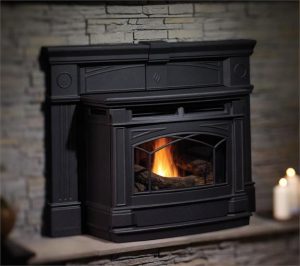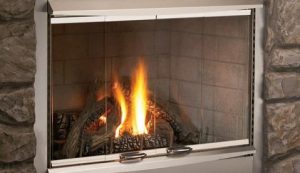Gas Fireplace Installation Guide
More and more homeowners in the Washington DC Metro Area are requesting our services to have a gas fireplace installed. A gas fireplace is a great investment for your home. It brings immediate charm and utility to a room in the form of attractive flames and warmth. It doesn’t need the labor of wood burning because it can simply be turned on. No cutting and storing wood, no cleaning up after a wood fire. Gas fireplaces add to the resale value of the home if installed correctly. Fortunately, you can convert wood-burning fireplaces into gas fireplaces. Read this to learn more. Fortunately, gas fireplaces can even be installed in homes that do not have a chimney.
 Gas fireplaces have many benefits. Gas fireplaces are amazing, but it should never be approached as a DIY project. It takes an expert to know which models will be best for the location, how to get the fuel (natural gas or propane) safely to the appliance, and what to do about the combustion gas that those attractive flames produce. Even though gas fireplaces should be installed by professionals, it is important for homeowners to understand what is involved in installing a gas fireplace. Here is all of the basic info a homeowner will need to make an educated decision about their gas fireplace installation.
Gas fireplaces have many benefits. Gas fireplaces are amazing, but it should never be approached as a DIY project. It takes an expert to know which models will be best for the location, how to get the fuel (natural gas or propane) safely to the appliance, and what to do about the combustion gas that those attractive flames produce. Even though gas fireplaces should be installed by professionals, it is important for homeowners to understand what is involved in installing a gas fireplace. Here is all of the basic info a homeowner will need to make an educated decision about their gas fireplace installation.
 Key points to look for in venting requirements are found in your municipality’s building codes and the manufacturer’s installation manual. These points include things like:
Key points to look for in venting requirements are found in your municipality’s building codes and the manufacturer’s installation manual. These points include things like:


 Gas fireplaces have many benefits. Gas fireplaces are amazing, but it should never be approached as a DIY project. It takes an expert to know which models will be best for the location, how to get the fuel (natural gas or propane) safely to the appliance, and what to do about the combustion gas that those attractive flames produce. Even though gas fireplaces should be installed by professionals, it is important for homeowners to understand what is involved in installing a gas fireplace. Here is all of the basic info a homeowner will need to make an educated decision about their gas fireplace installation.
Gas fireplaces have many benefits. Gas fireplaces are amazing, but it should never be approached as a DIY project. It takes an expert to know which models will be best for the location, how to get the fuel (natural gas or propane) safely to the appliance, and what to do about the combustion gas that those attractive flames produce. Even though gas fireplaces should be installed by professionals, it is important for homeowners to understand what is involved in installing a gas fireplace. Here is all of the basic info a homeowner will need to make an educated decision about their gas fireplace installation.
How Gas Fireplaces Are Installed
- Once the location and model of the gas fireplace are decided, the mechanics of installation come into play:
- Permits must be obtained & inspections planned for
- Building codes & the appliance manual must be checked for clearance requirements
- Gas supply lines must be laid properly
- Electrical circuits must be run if necessary
- Venting must be planned according to specific requirements
 Key points to look for in venting requirements are found in your municipality’s building codes and the manufacturer’s installation manual. These points include things like:
Key points to look for in venting requirements are found in your municipality’s building codes and the manufacturer’s installation manual. These points include things like:
- Distance the vent’s cap must be kept from windows, doors, corners, etc. are required because the gas being exhausted shouldn’t drift back inside
- Number of bends in the vent pipes and ratio of vertical/horizontal lengths affect the passage of combustion gas
- Distance from combustibles like insulation or framing might require heat shielding for fire safety
- Fireplace platform is built and put into place, making sure it is level
- Venting is sealed to the outside of the house and capped if not done previously
- Electric and gas lines are attached and checked for safety
- Clearances are double-checked before building in the unit

What To Look For In An Installer
It’s a good idea to do some research before picking someone to install your gas fireplace . You should also be familiar with frequently asked questions about fireplace installation. . You should also be familiar with frequently asked questions about fireplace installation. . You should also be familiar with frequently asked questions about fireplace installation. . You should also be familiar with frequently asked questions about fireplace installation.. If the provider of the unit also does installations, that is a good place to start. Look for these things:- Check their website and see what previous jobs look like
- Look for credentials like BBB (Better Business Bureau) ratings and reviews from locals
- Look for NFI and CSIA certifications
- See if they offer a free consultation for the project
- Ask for clear terms in the project proposal and make sure you understand everything
- Compliance with code regulations and manufacturer instructions
- Familiar with size, type, and features of various hearth appliances
- Use of proper materials for heat protection of walls and floors
- Aware of requirements for size, type, configuration, and height of venting system
- Able to select proper fuel
- Familiar with the guidelines for operation and maintenance of the hearth system

Frequently Asked Questions About Gas Fireplace Installation
- How often should I hire a chimney sweep to clean my gas fireplace? All fireplaces should be cleaned every year. You can learn more here.
- Will this gas fireplace work during a power outage? A standing pilot system is self-contained and will work even when there is no electricity. An electronic system will need to have dedicated wiring in place and will not work without electricity.
- Can I just use my existing chimney? Maybe. Modern appliances need modernized chimneys or incomplete combustion and/or water condensation will cause corrosion problems. A CSIA-certified installer will be able to assess your chimney and tell you what will be needed to make it useable. In many cases, a gas fireplace insert can be installed in an existing fireplace opening.
- I don’t have a chimney, is this going to be a problem? No. There are many modern gas fireplaces that do not need a traditional chimney. In fact, the flexibility of location means a gas fireplace can enhance almost any room in the house.
- Does the need for a vent limit location of a gas fireplace? A qualified installer can be amazingly creative in designing venting options for a challenging location because the installer is familiar with the building codes and the safety factors in venting different models. Ask about the possibilities and ask for estimates on cost because simpler installations will take less time.
- Can I go with a ventless gas fireplace? These fireplaces are designed to “safely” put combustion gasses and moisture back into the room where they are being used. They are illegal in many communities because of the potential safety hazards. If a licensed installer has deemed it impossible to use any other type of installation, make sure it is legal in your location and your home insurance company allows it. Be aware that it could affect the resale value of your home because potential buyers may be wary of ventless installations.
- Will I like the location of my gas fireplace in real life? A good way to judge whether a gas fireplace will be where you want it is to make a cardboard box the same size as the potential fireplace and place it exactly where you are thinking it will go. This way you can move it around if you don’t like the original plan, but keep installation requirements like building codes, venting, and gas lines in mind.
- How much will it cost to use a gas fireplace? National averages put the cost of a gas fireplace using 27,000 BTUs per hour will cost between 12-15 cents each hour but it’s a good idea to check the rates for your particular fireplace model and your area’s energy rates. Most homeowners report a reduction of fuel consumption and lower energy bills after installing a gas fireplace.
- Can I control the heat output of a gas fireplace? Some styles will use fans to push heat into the room or the home’s heat circulation system if desired (but not in a power outage). If this is a feature you want in your gas fireplace, choose a model that has the ability to control how much heat comes into the room. Many have thermostats that can be set for temperature control.
- Do I need a permit to install a gas fireplace? Probably. Since installing a gas fireplace involves things that affect safety, most municipalities insist on permits and installation by professionals. Most home insurance companies do, too.
- How much maintenance does a gas fireplace need? Most professional installers also offer maintenance because yearly inspections and cleanings are essential for continued safe operation. Follow the manual’s guidelines for your particular model and select an installer who will also provide this service.

It’s good to know that clearances are double-checked before moving on to ensure they are working properly. My partner and I are thinking about getting a new fireplace this year because we love using it at night. We aren’t very DIY oriented so we need to find some professionals that can do this for us.
Picking the best location for a gas fireplace could make a huge difference. That might be exactly the kind of thing we’ll need help with when deciding how to start the project since it’s going to factor into the rest of the installation. I’ll consult a gas fireplace expert in the area so they can give us some advice on where it would need to go.